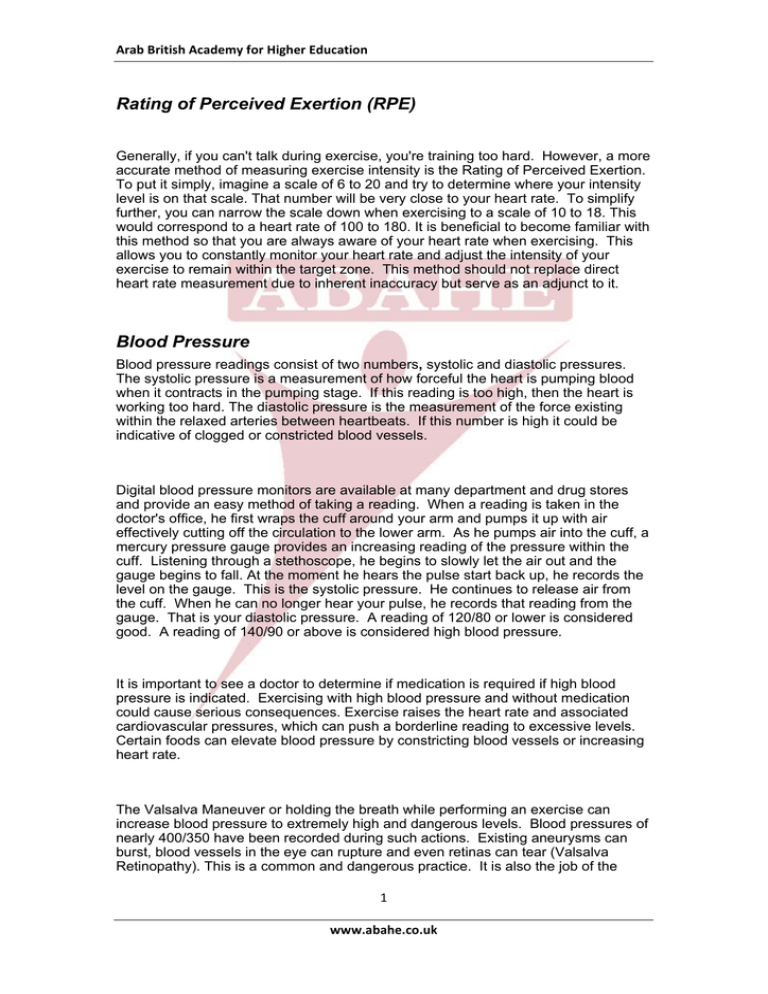
Arab British Academy for Higher Education Rating of Perceived Exertion (RPE)
Generally, if you can't talk during exercise, you're training too hard. However, a more
accurate method of measuring exercise intensity is the Rating of Perceived Exertion.
To put it simply, imagine a scale of 6 to 20 and try to determine where your intensity
level is on that scale. That number will be very close to your heart rate. To simplify
further, you can narrow the scale down when exercising to a scale of 10 to 18. This
would correspond to a heart rate of 100 to 180. It is beneficial to become familiar with
this method so that you are always aware of your heart rate when exercising. This
allows you to constantly monitor your heart rate and adjust the intensity of your
exercise to remain within the target zone. This method should not replace direct
heart rate measurement due to inherent inaccuracy but serve as an adjunct to it.
Blood Pressure
Blood pressure readings consist of two numbers, systolic and diastolic pressures.
The systolic pressure is a measurement of how forceful the heart is pumping blood
when it contracts in the pumping stage. If this reading is too high, then the heart is
working too hard. The diastolic pressure is the measurement of the force existing
within the relaxed arteries between heartbeats. If this number is high it could be
indicative of clogged or constricted blood vessels.
Digital blood pressure monitors are available at many department and drug stores
and provide an easy method of taking a reading. When a reading is taken in the
doctor's office, he first wraps the cuff around your arm and pumps it up with air
effectively cutting off the circulation to the lower arm. As he pumps air into the cuff, a
mercury pressure gauge provides an increasing reading of the pressure within the
cuff. Listening through a stethoscope, he begins to slowly let the air out and the
gauge begins to fall. At the moment he hears the pulse start back up, he records the
level on the gauge. This is the systolic pressure. He continues to release air from
the cuff. When he can no longer hear your pulse, he records that reading from the
gauge. That is your diastolic pressure. A reading of 120/80 or lower is considered
good. A reading of 140/90 or above is considered high blood pressure.
It is important to see a doctor to determine if medication is required if high blood
pressure is indicated. Exercising with high blood pressure and without medication
could cause serious consequences. Exercise raises the heart rate and associated
cardiovascular pressures, which can push a borderline reading to excessive levels.
Certain foods can elevate blood pressure by constricting blood vessels or increasing
heart rate.
The Valsalva Maneuver or holding the breath while performing an exercise can
increase blood pressure to extremely high and dangerous levels. Blood pressures of
nearly 400/350 have been recorded during such actions. Existing aneurysms can
burst, blood vessels in the eye can rupture and even retinas can tear (Valsalva
Retinopathy). This is a common and dangerous practice. It is also the job of the
1 www.abahe.co.uk Arab British Academy for Higher Education trainer or spotter to recognize when the breath is being held and bring it to the
exerciser's attention immediately.
Proper Attire for Specific Activity
Proper attire is just as important as all the other requirements for effective exercise.
Running shoes provide the needed heel cushioning but lack in the side to side lateral
support for required for aerobics. Aerobic shoes are generally available for women.
However, men's aerobic shoes are scarce. A good cross trainer shoe provides all
the necessary support for aerobics. Athletic shoes should fit properly. Break in
period does not apply to athletic shoes they should fit comfortably from the
beginning. Depending on the amount of use they get, insoles may wear out before
the shoes show signs of external wear.
It is important to wear clothing that allows the skin to breathe. The body utilizes
sweating to regulate temperature. Clothes that restrict the cooling of the skin are not
recommended. It's important to wear clothing that allows the body to ventilate. If
evaporation does not occur, the wet clothing will continue to help radiate body heat.
This can lead to loss of excess body heat after exercise when heat retention is
important.
Cotton soaks up sweat readily, but stays wet. Wool, however, continues to provide
body warmth even when wet. Nylon doesn't allow water to permeate through.
Obviously, layers are important in cold weather environments. Layers allow you to
remove and replace outer garments as the need arises. Hats are equally important
in cold weather since a considerable amount of body heat can be lost through the
head. In warm weather, wear loose clothing that allows sweat evaporation. Again,
cotton dries slower than man-made materials. A combination of cotton and polyester
combines the absorption and wicking qualities of each material.
Specific Aerobic Activities
Running
Use a good running shoe.
Land on the heel and rotate to the toe, except when sprinting stay on toes.
Use orthotic inserts if necessary.
Restrict vertical movement, don't slam down, and glide.
Stair Master
Use the handrails for balance only, not for support.
Keep back and head straight up in vertical alignment.
Using 8 to 10 inch step strokes uses 15% more energy.
Stationary Bicycle
Restrict side flex movement.
2 www.abahe.co.uk Arab British Academy for Higher Education
Assume upper body slightly forward with head upright.
Adjust seat for near full leg extension.
All Rights Reserved © Arab British Academy for Higher Education 3 www.abahe.co.uk

